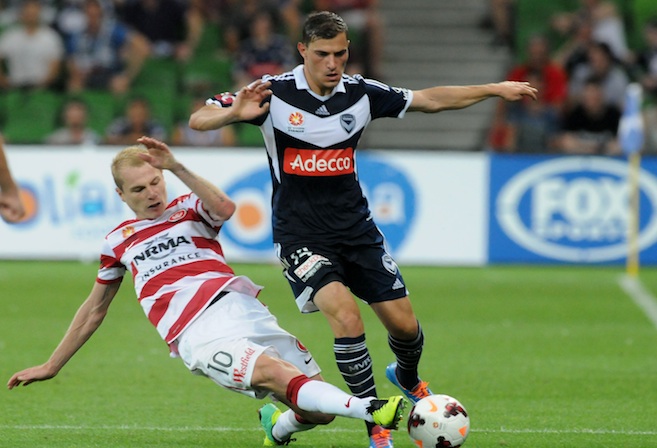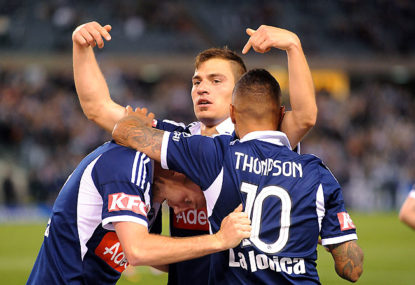Yesterday morning, Bruno Fornaroli accidentally assumed the role of communications manager at Melbourne City, tweeting out a photo of him posing with Fernando Brandan, Iacopo La Rocca and, most interestingly, Marcelo Carrusca.
Now, as the announcement of Carrusca’s signing hadn’t actually been made yet, the tweet was quickly deleted, but not before all the dexterously-digited Twits had seen and saved the scoop. The news was reported on all of the major Australian football media outlets, and the cat was out of the bag, clawing and meowing and kicking up its litter.
This kind of social media mishap is commonplace in sports these days, and it must be a nightmare for clubs. With 22 players, even more staff, a lot of them placed firmly in the age group that tends to Twitter, Instagram and the rest like a monk might the monastery gardens, and all of them need to be managed.
Direct interaction between the players and the fans has never been as easy as it is now, and for the sports media, it’s become a join-or-die situation when it comes to social media.
Stories like Carrusca’s signing might once have only been uncovered by dogged beat reporting, liaising with anonymous sources. Now, with leaks only a ‘send’ button away from oozing out, all you need is an internet connection and a refresh button.
Of course, the immediacy of networks like Twitter has also loosened certain journalistic standards. When James Troisi was seen, in the space of a few weeks, in New York City with Tim Cahill, then in Israel holding a Maccabi Haifa scarf, then back in Melbourne, these movements – all traced, Carmen Sandiego-style, on social media – were reported on, extrapolated, and made concrete in the media.
It turned out to be a red herring of Hitchcockian proportions, the George Kaplan of transfer sagas, because Troisi ended up re-signing with Melbourne Victory anyway. Every news outlet is petrified of losing readers – read: clickers – and relevance, and is forced to jump on any online tidbit that might bait a page view or two.
People click on tweets, we know this, so why wouldn’t they click on articles about tweets? Twitter is an animal that sheds and regrows its skin every few seconds; all those stories about Troisi that turned out to be wrong or irrelevant haven’t really hurt any of the outlets that wrote them.
 more commonly seen on a Canadian ice rink than it is a football pitch.
more commonly seen on a Canadian ice rink than it is a football pitch.
The footage of Austin being relieved of the air in his lungs was inevitably a hit on Twitter, and when Fox Football tweeted the vision out, describing it as “the best hit you’ll see this season”, Austin was quick to retort coarsely.
It’s probably not wise of Austin – however justified his irritation was – to enter into profane dialogue with the league broadcaster, but how can you expect him to lay his thumbs down when there are 140 sarky characters to exhaust?
Are sporting heroes best left, to a degree, unknowable? I’d have preferred not to know Stephanie Rice casually used homophobic slurs, or that Lebron James enjoys taking cringe-worthy, pompous selfies.
Players all over the world have tweeted their way into tangible trouble. Premier League players Rio Ferdinand, Andre Gray, Robert Huth and a horde of others have been punished by the English FA for inappropriately expressing themselves on Twitter over the last few years.
Gray was given a four-match ban while playing for Burnley last season for homophobic tweets he forced repugnantly out into the universe back in 2012; it seems the statute of limitations is generous here, and rightly so.
It’s easy to cheapen the gravitas of social media mutterings, effortless as they are to make, but in reality they are public statements, made to huge, listening crowds, and their impact just can’t be dismissed. In Australia, Brisbane Roar’s Director of Football Craig Moore is extremely active on Twitter, calling out journalists, conversing with ex-teammates, even quashing transfer rumours in 140 characters or less.
When the punishment for leaning on a dodgy tweet for a story is little more than a minor stumble, and the reward for unearthing a nugget of gold from the vast social media wasteland is a viral sensation, the choice is easy.
When players are as likely to break transfer news as club media departments, why not update that news feed a few more times per hour? The stories – and non-stories – are quite literally at one’s fingertips, and the negative effects of this accessibility are – if not quite being outweighed – at least being concealed by the sheer power of its convenience.
Being able to take part in an impromptu Q-and-A with a player as they’re on the team coach on the way to an away fixture is a privilege past generations would congeal with envy at.
Seeing a stunning wonder-goal replayed and enhanced literal seconds after it actually happens is something we can all guiltlessly indulge in. The sporting world has flocked as one, all tweeting at each other, a gaggle of social media devotees, enjoying the group benefits and surviving the pitfalls. Join or fly away.






























































































 more commonly seen on a Canadian ice rink than it is a football pitch.
more commonly seen on a Canadian ice rink than it is a football pitch.